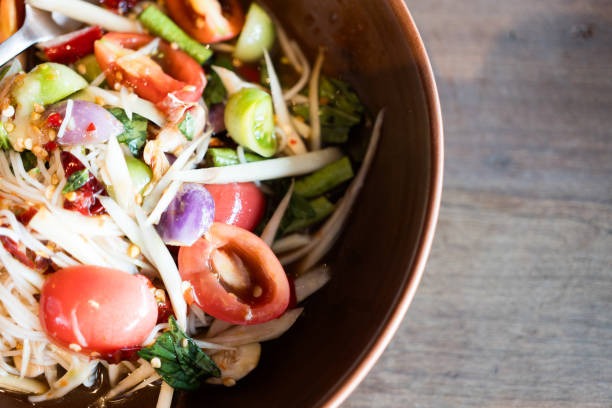From Seoul’s street food vendors to Kyoto’s home kitchens, East Asian cuisine is a rich, savory story crafted through centuries of history, geography, and culture. It is not just food—each meal is an expression of heritage, a ritual, a story on a plate.
While China, Japan, and Korea all have distinct cuisine, they also have some underlying principles that are present in all of East Asian cuisine that make it so fascinating: balance, respect for ingredients, and highly intimate food-to-family interaction.
But what is it, exactly, which makes East Asian food stand apart from the rest of the world? And how is it possible that it can be so widely adored? Let’s take a glance at the defining flavors, primary ingredients, and cultural habits that differentiate East Asian cuisine.
1. A Philosophy of Balance
It is possibly the most characteristic aspect of East Asian cuisine that it emphasizes balance—not flavor. There is never just one item to be eaten.Instead, there is a series of small things to be consumed together. There is sweetness balanced by saltiness, crunch balanced by softness, warmth balanced by coolness. In Korea, for instance, a standard meal consists of rice, soup, and several banchan (side dishes) ranging from fermented to pickled to raw.
In Japan, the meals often follow the ichiju-sansai rule: one soup, three sides, and a main, as a way of offering a variety of nutrients and textures. This is not just playing it safe to keep things interesting—it’s also a reflection of a broader cultural attitude that values harmony and focus when eating.
2. Fermentation as a must
Fermentation is a massive component of East Asian cooking. It’s not just a preservation method—it’s a depth and umami method.
In Korea, foods such as kimchi (fermented chilli, garlic, and fish sauce cabbage), doenjang (soybean paste), and gochujang (fermented red chilli paste) all include fermentation. These add intense, deep flavors to everyday meals. In Japan, soy sauce, miso, and sake are all the result of fermentation. Miso soup, a Japanese breakfast staple, is probiotic and comforting. China also has plenty of fermented foods: black bean sauce, pickled mustard greens, preserved tofu, etc. The long fermentation periods are characteristic of the East Asian ethos of food: slow, thoughtful, and tradition-driven.
3. The Power of Umami
If there’s one taste that comes together to unify East Asian cuisine, it’s umami—also known as the “fifth taste” after sweet, sour, salty, and bitter. Umami is the meaty, mouth-coating quality of mushrooms, soy sauce, seaweed, and age.
East Asian cuisine naturally enjoys and makes use of umami. Japanese dashi broth, a komi and bonito-flake stewed soup, is an example—subtle but deeply-satisfying. Chinese stir-fries incorporate oyster sauce or black beans to provide a blush of umami. And on the Korean table, fermented kimchi and fishy anchovy-flavored soups contribute deep richness even to the most unadorned meal.
4. Rice as the Meal’s Centerpiece
Rice isn’t just a side dish—it’s the centerpiece of the meal. In most cultures of East Asia, “meal” and “rice” are synonymous. It is a centering base upon which all the other flavors orbit and radiate on top.
Rice in China is simply steamed to balance strong sauces. In Japan, short-grain rice is subtly sticky, ideal for sushi, donburi, and bento containers. . Koreans have rice with almost every meal, sometimes adding it to soups or stews, or building bibimbap—a rice bowl covered in vegetables, egg, and gochujang.
Rice is not only food—it is identity, ritual, and the rhythm of the day.
5. Signature Dishes & Iconic Techniques
Each country in East Asia has its own approach, both in ingredients used and techniques learned.
Japan: Precision and Minimalism with lots of sea ingredients
Japan is famous for precision, seasonality, and aesthetics. Raw fish becomes an art in sashimi and sushi. Vegetables served in tempura are lightly battered and then deep-fried so that there is crispness but no oil. And then, naturally, there’s katsu curry, the rich hybrid dish that brings together crispy breaded pork or chicken cutlets and rich, subtly spicy Japanese curry. It’s easy enough to whip up at home with a katsu curry recipe, which is quite often merely employing store-bought curry roux, panko breadcrumbs, and a simple fry-up technique—evidence that even Japan’s fusion food is replete with thoughtful taste.
China: Diversity and Wok Hei
With its vast geography and geographical variation, it is not possible to define Chinese food in one term. Cantonese cuisine may be delicate and faintly seasoned, while Sichuan cuisine adds red hotness and numbing peppercorns. Wok preparation that produces charred flavor known as wok hei is a common technique in most of the country. Stir-frying, steaming, and braising are all preeminent aspects of the Chinese culinary DNA, producing food that is fast, fresh, and flavorful.
Korea:Bold Flavours and Comfort at the same time
Korean food prefers bold, fermented flavors and a sharing culture. Stews like kimchi jjigae, spicy rice cakes (tteokbokki), and grilled meats are all accompanied by a choice of dozens of banchan (side dishes). Korean BBQ is a chatty food that encourages conversation and communication. And comfort foods like japchae (glass noodles) and gyeran-jjim (steamed egg custard) show the soft, homely side of this tough-around-the-edges food.
6. Dining as Experience and Etiquette
With East Asian societies, the way you dine is almost as important as what you dine on. Eating is typically a shared experience, and table etiquette varies by nation.
In Japan, slurping noodles is to praise the chef. In Korea, elders are served first, and dishes are shared courses instead of being served individually. In China, there are numerous courses in banquets and numerous traditions too. There’s etiquette to the chopsticks, to sharing, to conversation or silence. Food isn’t rushed; it’s respected.
Food is more than just eating
East Asian cuisine is a rich expression of culture, philosophy, and heritage. It’s a celebration of balance, a virtuosity of fermentation, and a love of umami and simplicity. Whether you’re heating up a pot of miso soup for the family at home, experimenting with a new katsu curry recipe, or hanging out with friends over a Korean BBQ grill, you’re not just having good food—you’re having a slice of history.
And that’s what makes East Asian food so special. It’s heart food, memory food, meaning food—served with love, from family to family.

